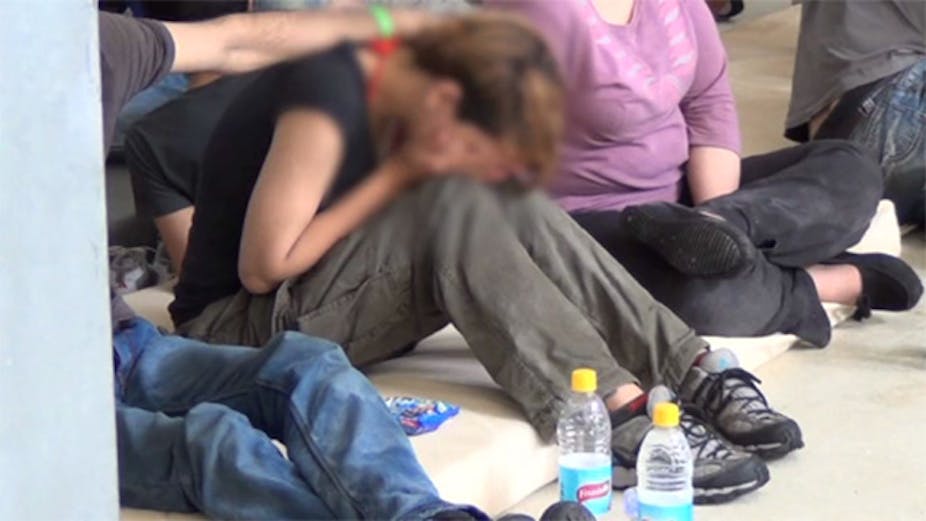The history of Australian asylum seeker policy is studded with iconic if often distressing imagery.
In the most recent addition, officials at Christmas Island filmed and photographed a young Iranian woman, supposedly at the moment when she learnt that she will never be allowed to live in Australia, due to the Rudd government’s recently announced immigration policy.
Department for Immigration and Citizenship (DIAC) says the image is intended to be seen around the world as a warning to other asylum seekers of what may happen to them if they catch a “leaky boat” to Australia. It now sits alongside images of “children overboard” and the Tampa affair in Australia’s political narrative.
But is this picture targeted towards overseas or domestic audiences? Who is the government most trying to reach with this undeniably affecting image - the boat people or the vote people?
The Conversation spoke with Professor Phillip George from the School of Media Arts at the University of New South Wales about the history of political images of asylum seekers and their effect on the body politic.
What does the image of the Iranian asylum seeker show us?
It looks like we are seeing a couple of people sitting on a floor weeping, heads in hands, and everything is thrown out of focus. I would probably say that because they were interviewed by a migration worker that it is a legitimate image and we can probably trace down the worker from the Immigration Department.
It would not be as contentious as say the “child overboard” images because we did not know who they were - but this image looks to be an easily verifiable image.

Can we be sure the image depicts what DIAC says it depicts?
I do not think we can be sure. You have come off a plane, a boat, you are jet-lagged, you are tired, you have been travelling - they could just be tired. They could just be emotional because they have finally got to their destination and they could actually be happy. We do not know because the image is thrown out of focus and you cannot read that body posture. Is it posture of despair? Is it relief? Is it exhaustion? Is it “I am really tired of being in this queue and people asking me these stupid questions”?
I would say that you could read a whole range of answers into that including: “I have just landed and I am not going to get into Australia and I am devastated.” It could be all of or none of the above in reading of that image.
Being a crowd photograph, you find someone who is doing what you want and you quickly turn your lens on that subject and you capture it. And it is a very cleverly warped image. I understand that the image has been shown in Indonesia and off-shore so it is advertising the event very quickly.
Is it an attempt to collect a political narrative?
This has been part of a re-election campaign. This is Labor’s Tampa image. I remember speaking to a Labor parliamentarian and they actually called it the “good-ship Tampa” and that it, in a way, a guaranteed re-election of the Howard government. So I think the image-makers are crafting an explicit and powerful, pertinent image for their re-election campaign.

How does the image compare to the “children overboard” image and the Tampa image in terms of its political message?
I think for the Tampa image the aerial photograph was a very dynamic, very powerful image of all these people sitting on the decks of boats and that was used by artists all over Australia for years after that.
But what the Tampa image did not do is actually show us human beings’ faces. We never saw the face of humanity on board. We only saw an aerial photograph.
With the “children overboard” we saw a scurrilous image of people in the water. Now were they in the water because the boat was sinking and they were trying to save the children by throwing them overboard? All we saw was a frame of people in the water. We were told what we were seeing there.
The interesting thing we have seen with this image is that it has been thrown out of focus. But if we left that video or camera running and put it in focus we could actually see faces looking up at the camera. It would be interesting to see the before, the after and the during of the taking of that image - so we could see the human faces.
What we do not want to see is the human faces because we get emotional, we have compassion. So the images are thrown out of focus so we have an icon, so we have a representation of someone’s face. But if we let the camera run, if we refocused and watched the image it would tell us a completely different story.
If the boats “keep coming” will the Rudd government or another future government need a tougher or more distressing image? Is this the method of political communication we have now established when it comes to communicating messages about asylum seekers?
I think we can almost guarantee that - particularly as we work into the election campaign, as Rudd ticks off all the boxes for his re-election. The icon of the Tampa and the “children overboard” are iconic images. The timing of this image is also quite exquisite. It is not only telling you that “you cannot come” but it also says, “look at this - we are showing you: you can’t come”.

